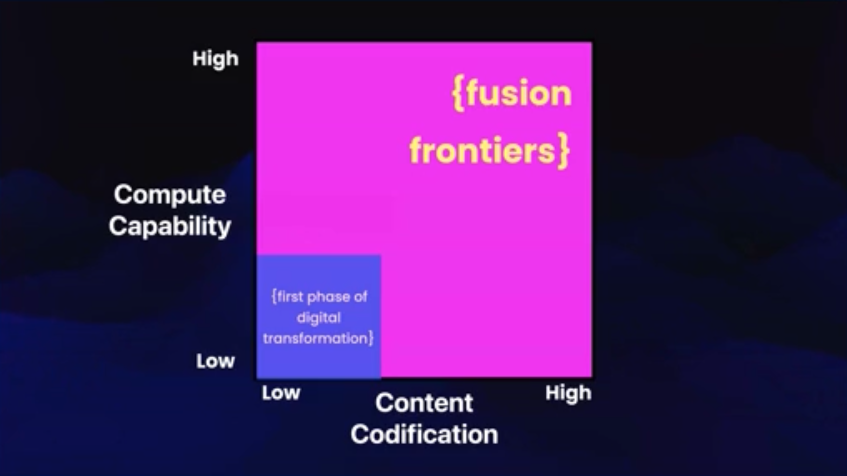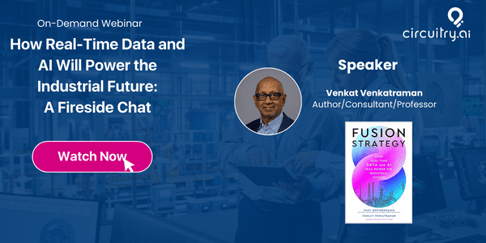In our latest webinar, Ashok Kartham, Founder and CEO of Circuitry.ai, was joined by Venkat Venkatraman, co-author of the book Fusion Strategy: "How Real-Time Data and AI Will Power the Industrial Future." We discussed how companies can use fusion strategies to combine industrial products with AI algorithms to deliver better value and outcomes to customers.
Keep reading for key takeaways or click here to watch the recording on-demand.
Digital disruption through datagraphs
In the last 15 years since the first smartphone was released, many analog businesses that could be digitized have done so. What is the underlying logic that makes digital companies work so well?
The answer is datagraphs. Datagraphs, a type of big data, lets you track in real time how customers use your products so you can make personalized recommendations for each customer. For example, Facebook, which has billions of active users, uses a social graph powered by big data and algorithms to decide what ads and content to push to each user.

Datagraphs are the foundation that supports fusion strategies, so it’s important to consider your company’s unique data and how to use it to create your signature datagraph.
Fusion frontiers
We’re just scratching the surface of what we can digitize. Now that computing resources are more affordable and faster, the fusion frontier over the next 10 to 15 years is the opportunity space for every company to explore what they can do when they have the computing capability and content codification.

How Tesla did fleet learning at scale
Telsa entered the automotive industry with a question: “What would happen when we design cars as computers on wheels connected to the cloud?”
They combined engineering, manufacturing, and software into one platform, eliminating any data silos. Everything is end-to-end on a vertically integrated platform that allows them to collect data as the cars are being driven. They are doing fleet learning at scale, scope, and speed with AI.
The role of GenAI in fusions strategies
Industries will develop their specific AI language to make that industry perform as effectively and efficiently as possible.
As industrial GenAI becomes the focus rather than consumer GenAI, the UX will change, the monetization will change, and the ecosystem will change. Everyone in the industrial sector should learn from the GenAI and the consumer sector and ask themselves: “What level of training do I need to provide for what kinds of models to come up with algorithms that will work to make my industry unlock value that otherwise is trapped in the siloed way of looking at this?”
How can companies implement fusion strategies?
The idea that a digital giant like Amazon, Alphabet, Microsoft, or Apple would come into your industry and disrupt it used to be far-fetched because everyone looked at competitors as companies they knew. Now, it's about competitors you don’t know.
First and foremost, consider whether you’ll be relevant in the next five years if your industry becomes digital and you don’t have the digital capabilities to transform.
With that in mind, you can start looking at your competitors, analyzing their abilities, and identifying the gaps in digital proficiency between your business and digital companies in your market. You might find those gaps so significant that unless you close them soon, you’ll find yourself disrupted.
Audience Q&A
What are some use cases where fusion strategies work?
VV: When I work with companies, I like to distinguish between designing a fusion product from scratch, for example, a completely new tractor, and modifying an existing tractor or adding sensors to the current tractor to make them transit data in real-time. Because the industrial sector is installation-based, the best use case to consider is the minimum viable addition to an existing product so you can start collecting relevant real-time data in use.
Once you do that, you can create your datagraph and use that data to make valuable recommendations to the customer.
From there, consider how to adapt your product's existing architecture while constantly exploring what the next version will look like.
How can automotive OEMs transition from mechanical repair service contracts to outcome-based contracts using connected vehicles’ data?
VV: The after sales and service market will be disrupted when everything becomes digital, but the digital will open up new service opportunities. For example, the whole idea of break/fix is that you can’t predict when something will break, and you can only fix it after the fact. With datagraphs, you can know when a part will likely break, so if you can now observe every part in the car and know when something will break, you can proactively do that as a bundled or transaction contract.
How can manufacturers that own the entire customer operations penetrate the fusion frontier?
VV: You need to earn the customer’s trust so they’ll allow you to manage more than your product. This means you need to show the customer that you can be independent and act as the agent for the customer, not as the agent for the manufacturer.
For example, Case IH wants to create a system for a farm and integrate with John Deere and other peripheral companies while collecting data from Bayer or Cargill. First, Case IH needs to earn the farmer’s trust and convince them to trust a manufacturer because they understand how the manufacturing product interconnects with other manufacturing systems instead of a third party.
How is the automation of decisions and actions using AI algorithms crucial to succeeding with fusion strategies?
VV: We must automate decisions when we are most confident that the heuristics have been adequately tested and verified. This is because trust in a company now rests on the decisions and actions taken by AI assistants and agents. Many companies rush to automate to exploit efficiency gains and may lose customer and stakeholder trust. As we write in our book, companies must demonstrate transparency in using the data and arrive at decisions to gain trust. In the industrial age, trust and brand image were due to product quality and reliability. In the AI age, it is about the veracity of algorithms and the explainability of decisions and actions.
Unlock the Future
Watch the full webinar here to learn more about the future of fusion strategies and how to incorporate them into your business.
